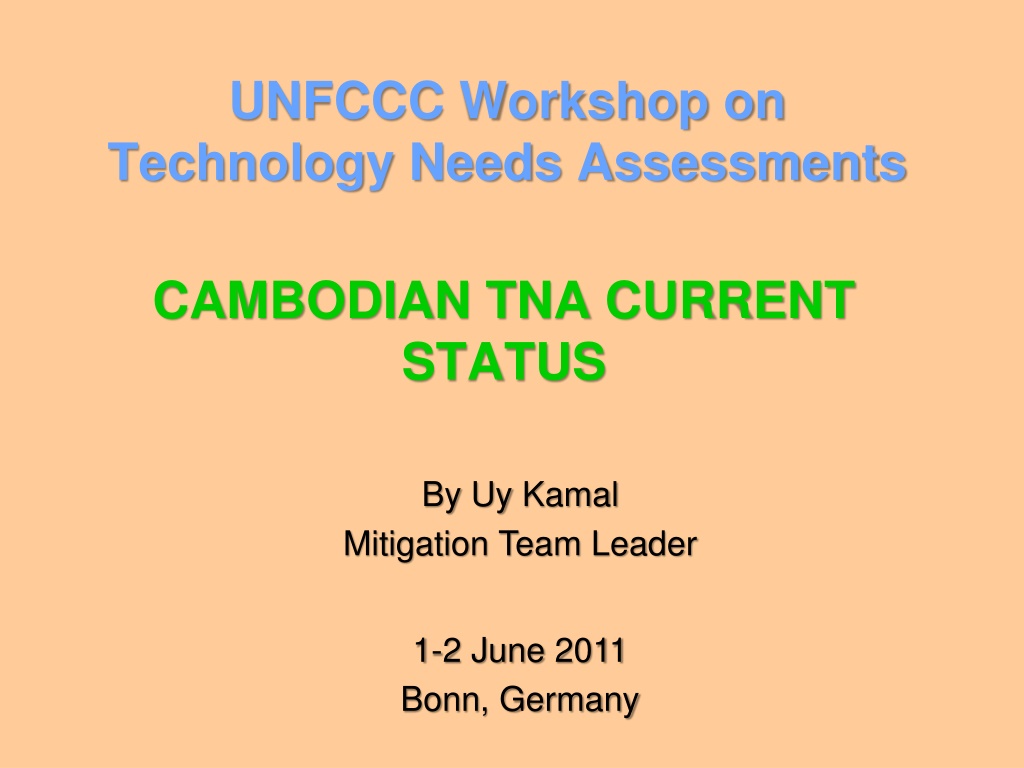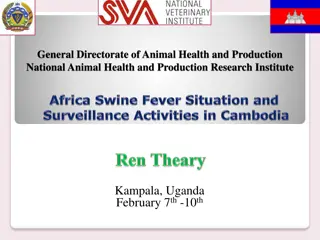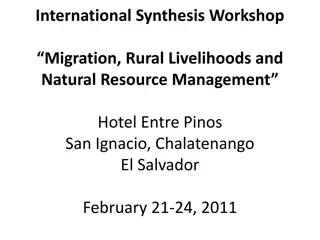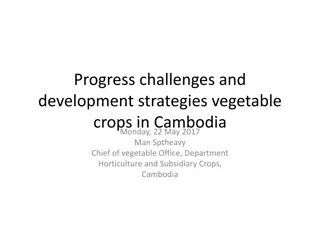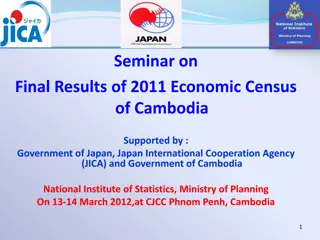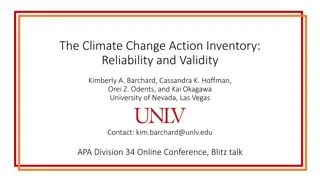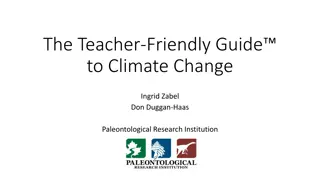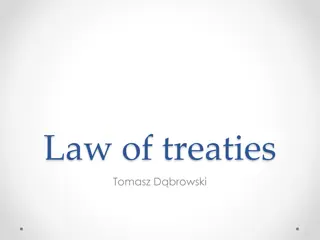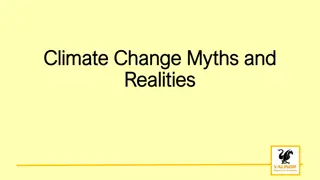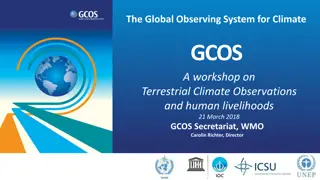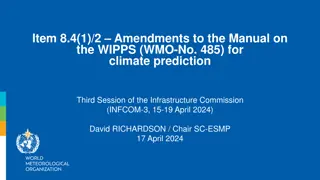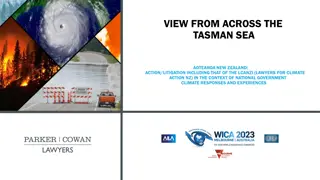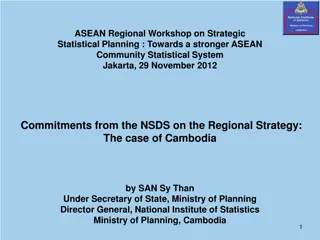Climate Change Technology Needs Assessment Workshop in Cambodia
The UNFCCC Workshop on Technology Needs Assessments in Cambodia focused on organizing for TNA, identifying development priorities related to climate change, and utilizing technology analysis and prioritization tools. The workshop highlighted the importance of national coordination, institutional structures, and capacity-building initiatives to enhance climate change mitigation and adaptation efforts in the country. By leveraging existing government documents and engaging key stakeholders, Cambodia aims to address climate change challenges effectively through the adoption of appropriate technologies and strategies.
Download Presentation

Please find below an Image/Link to download the presentation.
The content on the website is provided AS IS for your information and personal use only. It may not be sold, licensed, or shared on other websites without obtaining consent from the author. Download presentation by click this link. If you encounter any issues during the download, it is possible that the publisher has removed the file from their server.
E N D
Presentation Transcript
UNFCCC Workshop on Technology Needs Assessments CAMBODIAN TNA CURRENT STATUS By Uy Kamal Mitigation Team Leader 1-2 June 2011 Bonn, Germany
Contents 1. Getting organized for TNA 2. Identify development priorities related to CC 3. Technology analysis and prioritization using MCDA Model 4. Lessons learned
1. Getting Organized for TNA (1/3) National Climate Change Mngt. Structure TNA Coordination and Implement Structure
1. Getting Organized for TNA (2/3) Cambodia uses its existing climate change institutional structure to implement TNA project: The National Climate Change Committee (NCCC) serves as the National TNA Project Steering Committee The Climate Change Department serves as the Project Coordinator Selected members of the CDM Inter-ministerial and Adaptation Ad-hoc Working Groups are invited to join the National TNA Teams (mitigt. & adapt.) The National TNA Teams are supported by national consultants/experts (Academic and research institute)
1. Getting Organized for TNA (3/3) From regional Capacity Building to National Action The 1stRCB Workshop Sept 15-17, 2010 The 2ndRCB Workshop Jan 18-21, 2011 The TNA Handbook, the Multi-Criteria Decision Analysis (MCDA) Techniques, Cost and Financial Model, Technology Fact sheet, Technology-Barrier Analysis, etc., were introduced.
2. Identify development priorities relate to CC Use existing key gov t documents i.e. The Cambodian MDGs, The Rectangular Strategy, The National Strategic Development Plan (NSDP) Update 2009-2013, Sectoral Strategic Plans, National Adaptation Programme of Action (NAPA), Draft Second National Communication (SNC), and other sources such as ClimateTechWiki, etc. A preliminary list of proposed adaptation and mitigation options/technologies has been selected.
2.1 Priority sectors and sub-sector for CC adaption and mitigation (1/4) Examples in Adaptation Sub-sector Technology Rice production Water saving measures Irrigation strategies Improved drought resistance of rice crop strains Improved seed varieties Changes in consumer behavior concerning food Drought-resistant crop varieties (biotechnology) Improved crops distribution systems Crop rotation systems Crop research and development Gene technology Food crops Livestock Animal feed changes Improved animal husbandry practices Changes in location or animal type
2.1 Priority sectors and sub-sector for CC adaption and mitigation (2/4) Examples in Adaptation Sub-sector Water Supply for Agriculture Technology Increase reservoir technology Efficiency irrigation systems Water Demand for Agriculture Increase water use technology Reduce leakage in distribution systems Seasonal forecasting Water demand management Coastal Protection Dikes, levees (dam), floodwalls Detached breakwaters Floodgates, tidal barriers Saltwater intrusion barriers Wetland restoration
2.1 Priority sectors and sub-sector for CC adaption and mitigation (3/4) Examples in Mitigation Energy Option/Technology Grid Connection REEs, Grid Connection Auto Producers, Grid Connection Battery Charging Station, Solar Power Plant, and Solar Home System. Hybrid Cars, Motor Vehicle Inspection, Electric scooters and Bicycles, Public transport, etc., Energy Industries Transport Sector Rice cultivation Rice Milling Efficiency/Technology Change, Garment Industry Efficiency/Technology Change, Brick Works Efficiency/Technology Change
2.1 Priority sectors and sub-sector for CC adaption and mitigation (4/4) Examples in Mitigation Non-Energy Technology Agriculture Composting, Biogas effluent, Posphogypsum Rice cultivation Livestock Small Scale Biogas, Aquaculture/healthy diet Organic input agriculture, Bio-Slurry, Crop Management Agricultural soil management Urban Cook stove, REDD+, Agro-forestry, Rural Cook stove Land Use Change and Forestry
2.2 Priority sectors and sub-sector for climate change mitigation (1/4) National GHG Inventory GHG Emission By Sector LUCF Agriculture Energy Waste Total Total CO2eq 23600.36 21113.40 2059.86 % 50.21 44.92 4.38 0.49 100.00 229.24 47002.85 (Source: GHG Inventory report 2009)
2.2 Priority sectors and sub-sector for climate change mitigation (2/4) Sector Rating Scheme GHG Reduction Potential Economic Priorities Social Priorities Environmental Priorities Sector Total Benefit 5 4 4 5 18 Energy 4 4 5 4 17 LUCF 5 4 4 3 16 Agriculture 3 3 4 4 14 Waste 4 3 2 3 12 Industrial processes Solvent and other product use 3 2 2 2 9 Note: Rating Scheme: 0: no benefit, 1: faintly desirable, 2: fairly desirable, 3: moderately desirable, 4: very desirable, and 5: extremely desirable.
2.2 Priority sectors and sub-sector for climate change mitigation (3/4) Sub-sector rating scheme Environme ntal Priorities GHG Reduction Potential Economic Priorities Social Priorities Total Benefit Sector &Subsector 1. Energy Energy Industries 5 3 5 5 18 Other sectors* 5 5 4 3 17 Transport Manufacturing industries and construction Other (please specify) 4. Agriculture Rice cultivation Enteric fermentation Agricultural soils Manure management Field burning of agricultural residues Prescribed burning of savannahs Other (please specify) 4 4 3 4 15 5 3 3 4 15 3 4 4 2 13 4 3 4 4 3 3 2 3 4 5 5 3 15 14 14 3 2 4 3 12 2 2 3 2 9 2 2 2 2 8 0 0 0 0 0
2.2 Priority sectors and sub-sector for climate change mitigation (4/4) Sub-sector rating scheme 5. Land-use change and forestry Forest and grassland conversion Changes in forest and other woody biomass stocks Abandonment of managed lands Other (please specify)** CO2 emissions and removals from soil 6. Waste Other (Recycling, composting, etc.) Waste-water handling Solid waste disposal on land Waste incineration 5 4 4 5 18 4 4 5 4 17 4 4 4 4 16 0 0 0 0 0 0 0 0 0 0 3 3 4 4 14 3 3 3 3 12 3 2 3 3 11 2 2 3 3 10
3. Technology Analysis and prioritization by using MCDA Model Technology selection in transport sub-sectors- a result from MCDA Model Costs GHG Mitigation Development benefits Total 1 Hybrid Cars 2 Motor Vehicle Inspection 3 Electric scooters and Bicycles 4 City Transport Master Plan 5 Public city transport 4.5 18.8 22.8 23.2 30.1 1.5 1.6 3.2 2.8 3.9 15.9 14.8 16.2 14.9 20.6 21.8 35.2 42.1 40.8 54.6 Prioritized technology base on development benefits Transportation Public city transport Electric scooters and Bicycles Hybrid Cars 30.1 3.9 20.6 54.6 22.8 4.5 3.2 1.5 16.2 15.9 42.1 21.8
The first draft synthesis reports on TNA for mitigation and adaptation have been submitted for comments
Next Step: 2ndNational Consultation - To explore further feedback on the draft synthesis TNA report, - To identify barriers and propose solution for each identified technology and TAP Sector Sub-sector Technology Barriers Propose solution ? Energy Efficient Urban Mass Transport Vehicle Emission Standards Energy Efficient Lighting Energy Efficient Appliances ? ? ? ? ? ? ?
4. Lessons learned The existing national climate change institution, where adaptation and mitigation working groups are ready, is relevant for TNA in Cambodia. SNC provides significant sources of mitigation options/technologies a good base for TNA development MCDA model is good tool to prioritize potential technologies, but it still needs practical exercise by local experts There should have referent value, such as cost, GHG mitigation, and the benefit of common typical technologies to be available for reference. TNA shall contribute to the development of the to-be- prepared National Strategy and Action Plan on Climate Change, NAMA, etc.
Thank you very much for your attention!
